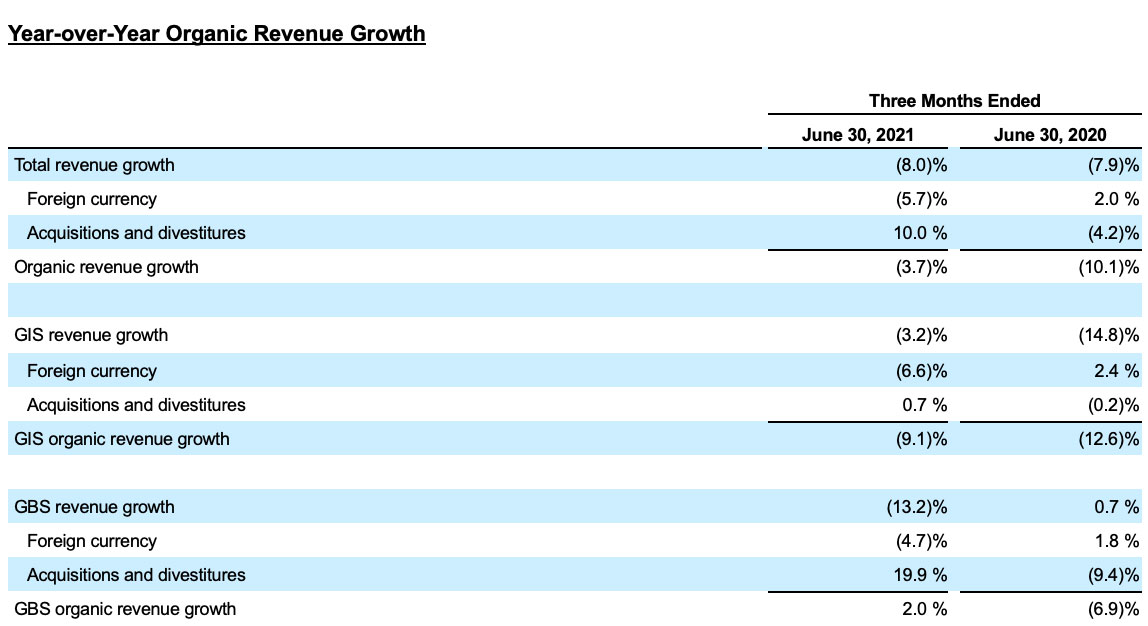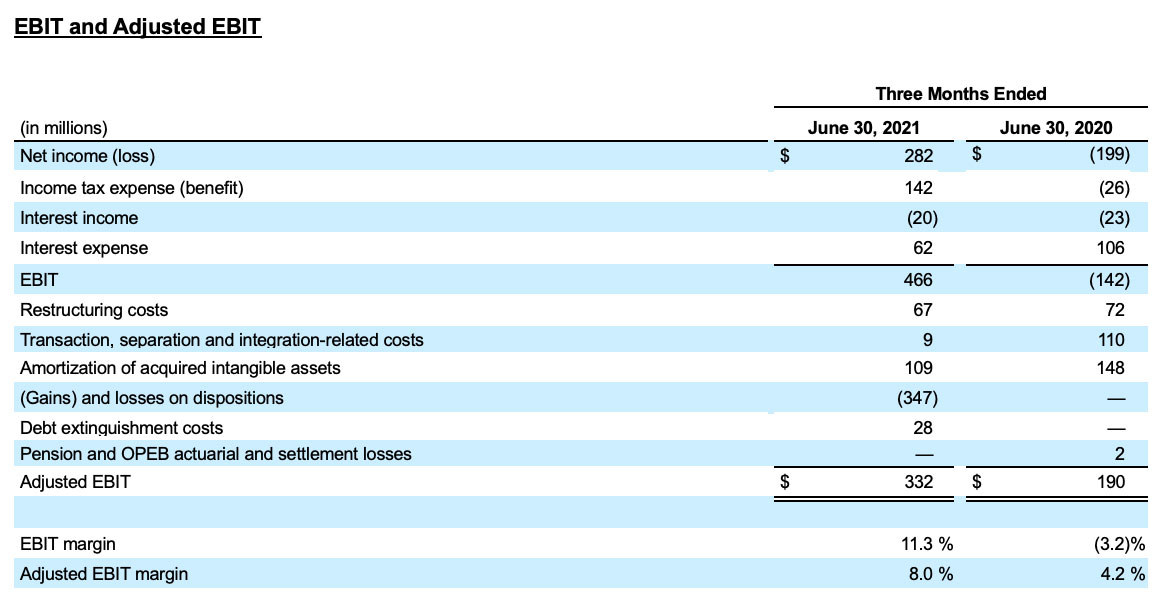DXC Technology Reports First Quarter Fiscal Year 2022 Results
- First quarter revenues of $4.14 billion, down 8.0% as compared to prior year, and down 3.7% on an organic growth basis
- Net income was $282 million compared to a net loss of $199 million in the prior year quarter; EBIT was $466 million, or 11.3% of sales, as compared to (3.2)% in the prior year quarter; first quarter Adjusted EBIT margin was 8.0%, as compared to 4.2% in the prior year
- Diluted EPS was $1.07 compared to $(0.81) in the prior year quarter. Non-GAAP diluted EPS was $0.84, up 300% compared to $0.21 in Q1 FY21
- Revenue, Adjusted EBIT margin, and Non-GAAP EPS exceeded our previous Q1 FY22 guidance range
- Bookings of $4.6 billion and book-to-bill ratio of 1.12x in Q1 FY22
- Reduced debt by $579 million in Q1 FY22, achieving our targeted debt level of approximately $5.0 billion, further strengthening our balance sheet
TYSONS, Va., August 4, 2021 – DXC Technology (NYSE: DXC) today reported results for the first quarter fiscal year 2022.
“Our results show that DXC continues to achieve on its short-term and longer-term financial objectives. We have encouraging revenue performance, margins are expanding, and our bookings clearly demonstrate that we continue to win in the marketplace,” said Mike Salvino, President and Chief Executive Officer, DXC. “With the stabilization phase of our transformation journey behind us, we are now moving through the foundation phase and remain focused on engaging our colleagues, increasing the level of customer intimacy, and making sure we have the strong financial foundation necessary to support growth."
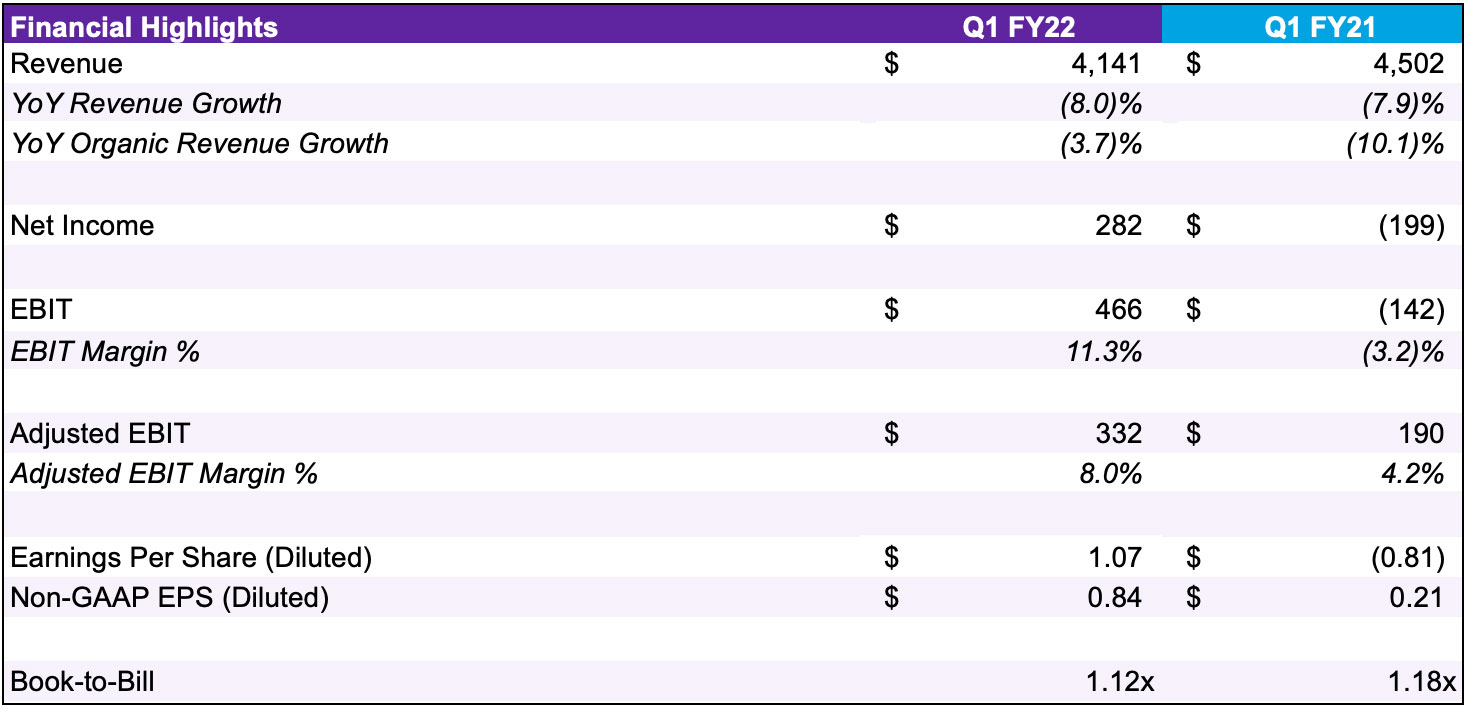
Financial Highlights - First Quarter of Fiscal Year 2022
Revenue was $4.141 billion, down 8.0% as compared to prior year, and down 3.7% on an organic basis. First quarter revenues exceeded the Company’s revenue guidance range.
Net income was $282 million compared to a net loss of $199 million in the prior year quarter. EBIT was $466 million or 11.3% of sales and included the following items: A $347 million net gain related to dispositions, amortization of intangible assets of $109 million, debt extinguishment costs of $28 million, restructuring costs of $67 million, and transaction, separation, and integration costs of $9 million. Excluding these items, Adjusted EBIT margin was 8.0% in the first quarter, an improvement of 380 bps as compared to the prior year quarter. First quarter Adjusted EBIT margin came in above our guidance range.
Diluted earnings per share was $1.07 and Non-GAAP diluted earnings per share was $0.84 in the first quarter of fiscal year 2022, driven by the improvement in margins, lower interest expense, and a lower tax rate. Non-GAAP EPS exceeded the Company's previous guidance range.
Book-to-bill for the quarter was 1.12x, underscoring the Company’s continued focus on delivering for our customers and colleagues, which in turn is driving ongoing success in the market. This represents the fifth straight quarter that DXC has delivered a book-to-bill of over 1.0x.
Financial Information by Segment

GBS segment revenue was $1.887 billion in the first quarter of fiscal year 2022, down 13.2% compared to prior year, and up 2.0% on an organic basis. GBS Segment profit was $272 million and segment profit margin was 14.4%, up 450 bps as compared to the first quarter of fiscal year 2021. GBS bookings for the quarter were $2.4 billion for a book-to-bill of 1.29x.

GIS Segment revenue was $2.254 billion in the first quarter of fiscal year 2022, down 3.2% compared to prior year, and down 9.1% on an organic basis. GIS segment profit was $131 million with a segment profit margin of 5.8%, a 480 bps margin expansion as compared to first quarter of fiscal year 2021. GIS bookings were $2.2 billion in the quarter for a book-to-bill of 0.97x.
Enterprise Technology Stack Highlights
The components of the Enterprise Technology Stack are as follows:
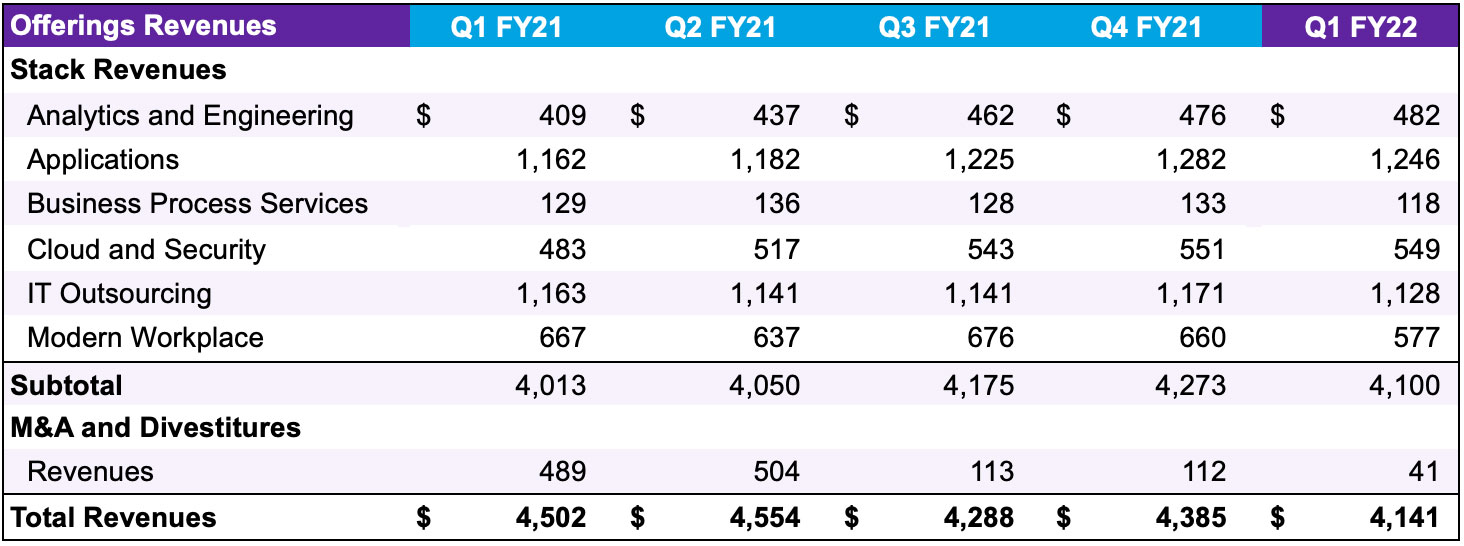
Cash Flow

Cash flow from operations was a use of $29 million in the first quarter of fiscal year 2022, and capital expenditures were $275 million. Free cash flow (cash flow used in operations less capital expenditures) was $(304) million in the first quarter of FY22, as compared to $(106) million in the first quarter of FY21.
Guidance
The Company's guidance for the second quarter and full fiscal year 2022 is as follows:
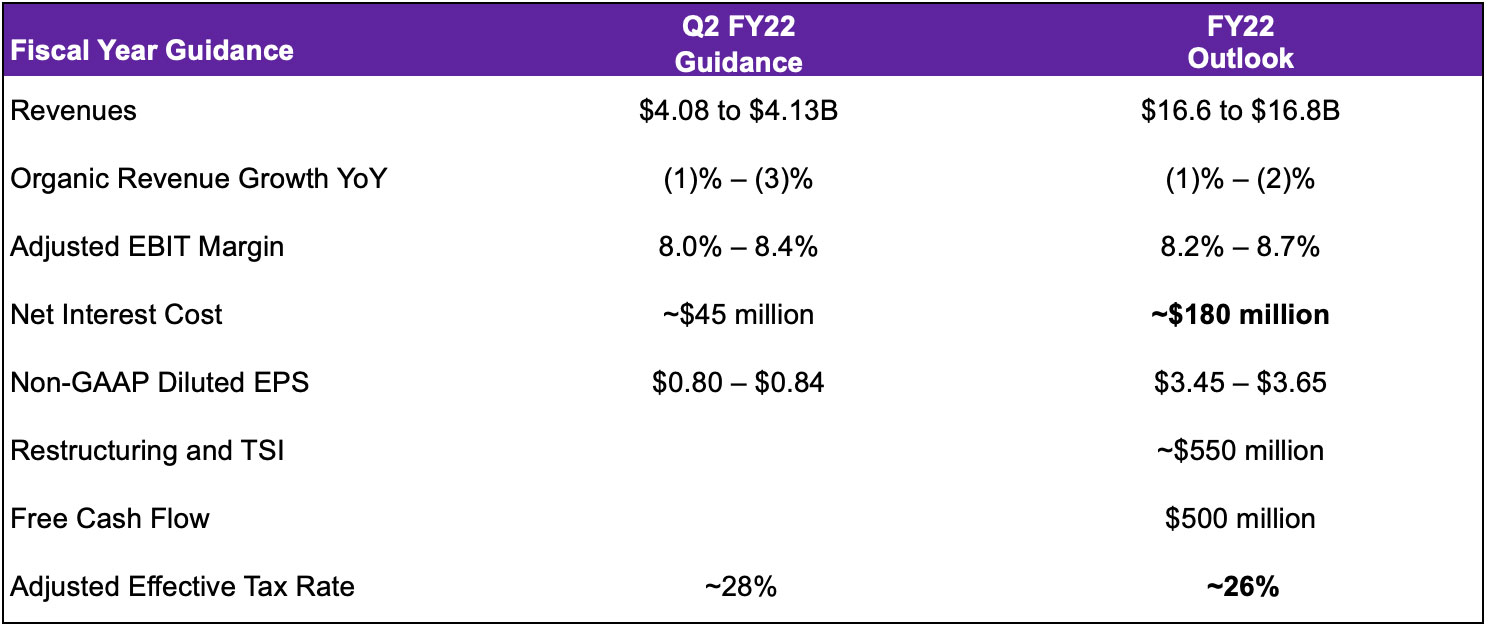
The Company reaffirmed its longer-term guidance:
- Positive organic revenue growth of 1% to 3% for fiscal year 2024
- Adjusted EBIT margin of 10% to 11% in fiscal year 2024
- Non-GAAP diluted EPS of $5.00 to $5.25 in fiscal year 2024
- Free cash flow of approximately $1.5 billion in fiscal year 2024
- Restructuring and TSI of approximately $100 million in fiscal year 2024
DXC does not provide a reconciliation of Non-GAAP measures that it discusses as part of its guidance because certain significant information required for such reconciliation is not available without unreasonable efforts or at all, including, most notably, the impact of significant non-recurring items. Without this information, DXC does not believe that a reconciliation would be meaningful.
Ken Sharp, Chief Financial Officer, DXC commented: “We have further strengthened our balance sheet, and clearly demonstrated our commitment to a strong investment grade credit profile, achieving our targeted debt level of approximately $5 billion. To offset dilution from incentive compensation, we have resumed returning capital to our shareholders in the form of share repurchases. Our longer-term objective is to retain our attractive leverage profile, invest in our business, and fund additional capital deployment to our shareholders through internally generated sources.”
Earnings Conference Call and Webcast
DXC Technology senior management will host a conference call and webcast to discuss these results on August 4, 2021, at 5:00 p.m. EDT. The dial-in number for domestic callers is +1 (833) 979-2847. Callers who reside outside of the United States should dial +1 (236) 714-2943. The passcode for all participants is 4469601. The webcast audio and any presentation slides will be available on DXC Technology’s Investor Relations website.
A replay of the conference call will be available from approximately two hours after the conclusion of the call until 08/11/2021 23:59 ET. Phone number for the replay is +1 (800) 585-8367 or +1 (416) 621-4642. The replay passcode is 4469601.
About DXC Technology
DXC Technology (NYSE: DXC) helps global companies run their mission critical systems and operations while modernizing IT, optimizing data architectures, and ensuring security and scalability across public, private and hybrid clouds. The world’s largest companies and public sector organizations trust DXC to deploy services across the Enterprise Technology Stack to drive new levels of performance, competitiveness, and customer experience. Learn more about how we deliver excellence for our customers and colleagues at DXC.com.
Forward-Looking Statements
All statements in this press release that do not directly and exclusively relate to historical facts constitute “forward-looking statements.” These statements represent current expectations and beliefs, and no assurance can be given that the results described in such statements will be achieved. Such statements are subject to numerous assumptions, risks, uncertainties and other factors that could cause actual results to differ materially from those described in such statements, many of which are outside of our control. Furthermore, many of these risks and uncertainties are currently amplified by and may continue to be amplified by or may, in the future, be amplified by, the coronavirus disease 2019 (“COVID-19”) pandemic and the impact of varying private and governmental responses that affect our customers, employees, vendors and the economies and communities where they operate. For a written description of these factors, see the section titled “Risk Factors” in DXC’s Annual Report on Form 10-K for the fiscal year ended March 31, 2021, and any updating information in subsequent SEC filings, including DXC’s upcoming Quarterly Report on Form 10-Q for the quarterly period ended June 30, 2021.
No assurance can be given that any goal or plan set forth in any forward-looking statement can or will be achieved, and readers are cautioned not to place undue reliance on such statements which speak only as of the date they are made. We do not undertake any obligation to update or release any revisions to any forward-looking statement or to report any events or circumstances after the date of this presentation or to reflect the occurrence of unanticipated events except as required by law.
About Non-GAAP Measures
In an effort to provide investors with supplemental financial information, in addition to the preliminary and unaudited financial information presented on a GAAP basis, we have also disclosed in this press release preliminary Non-GAAP information including: Earnings before interest and taxes ("EBIT"), EBIT margin, Adjusted EBIT, Adjusted EBIT margin, Non-GAAP income before income taxes, Non-GAAP net income, Non-GAAP EPS, organic revenues, organic revenue growth, and free cash flow.
We believe EBIT, EBIT margin, Adjusted EBIT, Adjusted EBIT margin, Non-GAAP income before income taxes, Non-GAAP net income and Non-GAAP EPS provide investors with useful supplemental information about our operating performance after excluding certain categories of expenses.
We believe organic revenues provides investors with useful supplemental information about our revenues after excluding the effect of currency exchange rate fluctuations for currencies other than U.S. dollars and the effects of acquisitions and divestitures in the periods presented. See below for a description of the methodology we use to present organic revenues.
One category of expenses excluded from Adjusted EBIT, Non-GAAP income from continuing operations before tax, Non-GAAP net income and Non-GAAP EPS, incremental amortization of intangible assets acquired through business combinations, may result in a significant difference in period over period amortization expense on a GAAP basis. We exclude amortization of certain acquired intangible assets as these non-cash amounts are inconsistent in amount and frequency and are significantly impacted by the timing and/or size of acquisitions. Although DXC management excludes amortization of acquired intangible assets primarily customer-related intangible assets, from its Non-GAAP expenses, we believe that it is important for investors to understand that such intangible assets were recorded as part of purchase accounting and support revenue generation. Any future transactions may result in a change to the acquired intangible asset balances and associated amortization expense.
Another category of expenses excluded from Adjusted EBIT, Non-GAAP income from continuing operations before tax, Non-GAAP net income and Non-GAAP EPS, impairment losses, may result in a significant difference in period over period expense on a GAAP basis. We exclude impairment losses as these non-cash amounts, reflect generally an acceleration of what would be multiple periods of expense and do not expect to occur frequently. Further assets such as goodwill may be significantly impacted by market conditions outside of management’s control.
There are limitations to the use of the Non-GAAP financial measures presented in this report. One of the limitations is that they do not reflect complete financial results. We compensate for this limitation by providing a reconciliation between our Non-GAAP financial measures and the respective most directly comparable financial measure calculated and presented in accordance with GAAP. Additionally, other companies, including companies in our industry, may calculate Non-GAAP financial measures differently than we do, limiting the usefulness of those measures for comparative purposes between companies.
Selected references are made to revenue growth on an “organic basis” so that certain financial results can be viewed without the impact of fluctuations in foreign currency rates and without the impacts of acquisitions and divestitures from “organic basis” financial results, thereby providing comparisons of operating performance from period to period of the business that we have owned during all periods presented. Organic revenue growth is calculated by dividing the year-over-year change in GAAP revenues attributed to organic growth by the GAAP revenues reported in the prior comparable period. Revenue growth on an “organic basis” is a Non-GAAP financial measure calculated by translating current period activity into U.S. dollars using the comparable prior period’s currency conversion rates after excluding the impact of acquisitions and divestitures. This approach is used for all results where the functional currency is not the U.S. dollar.
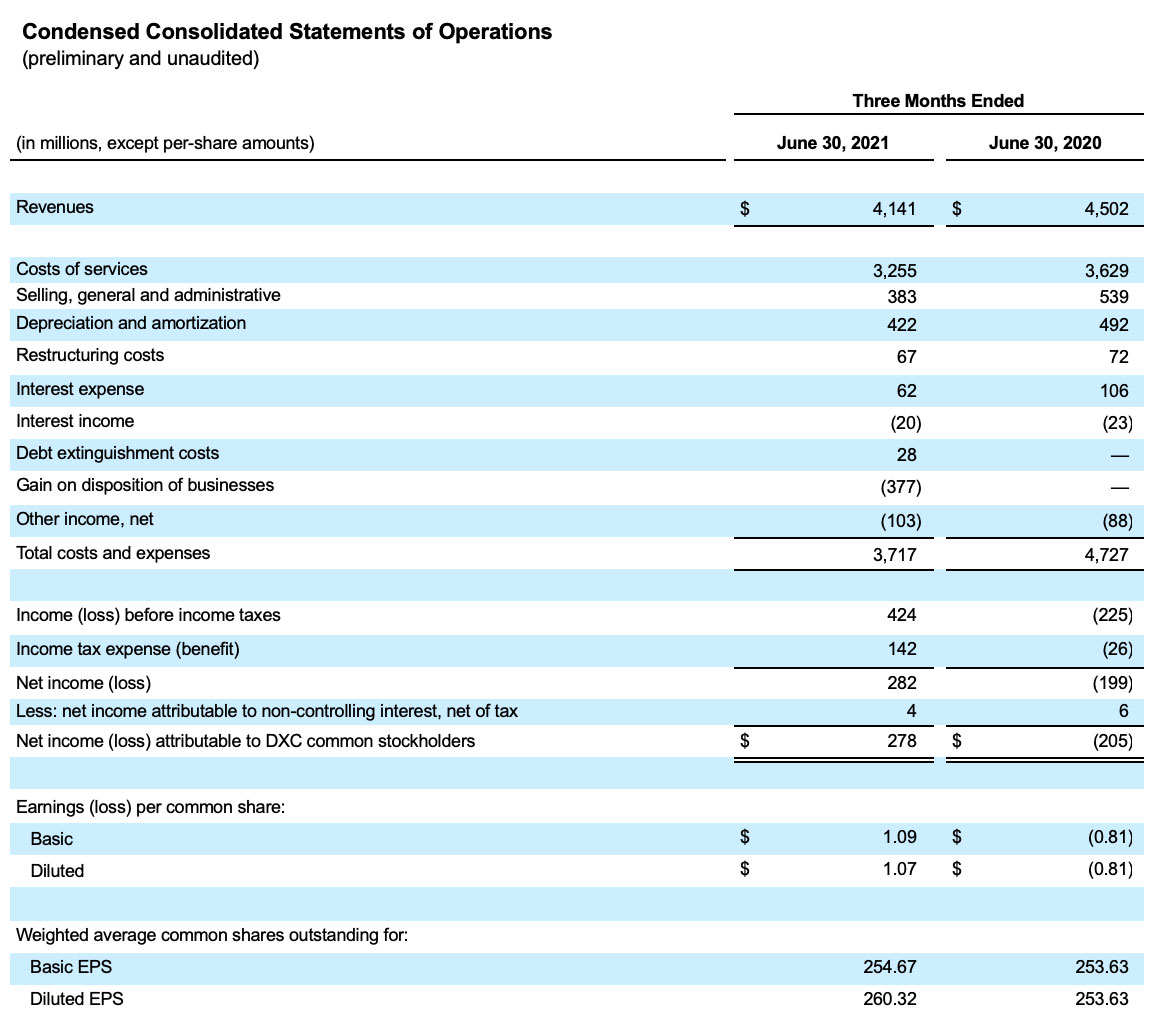
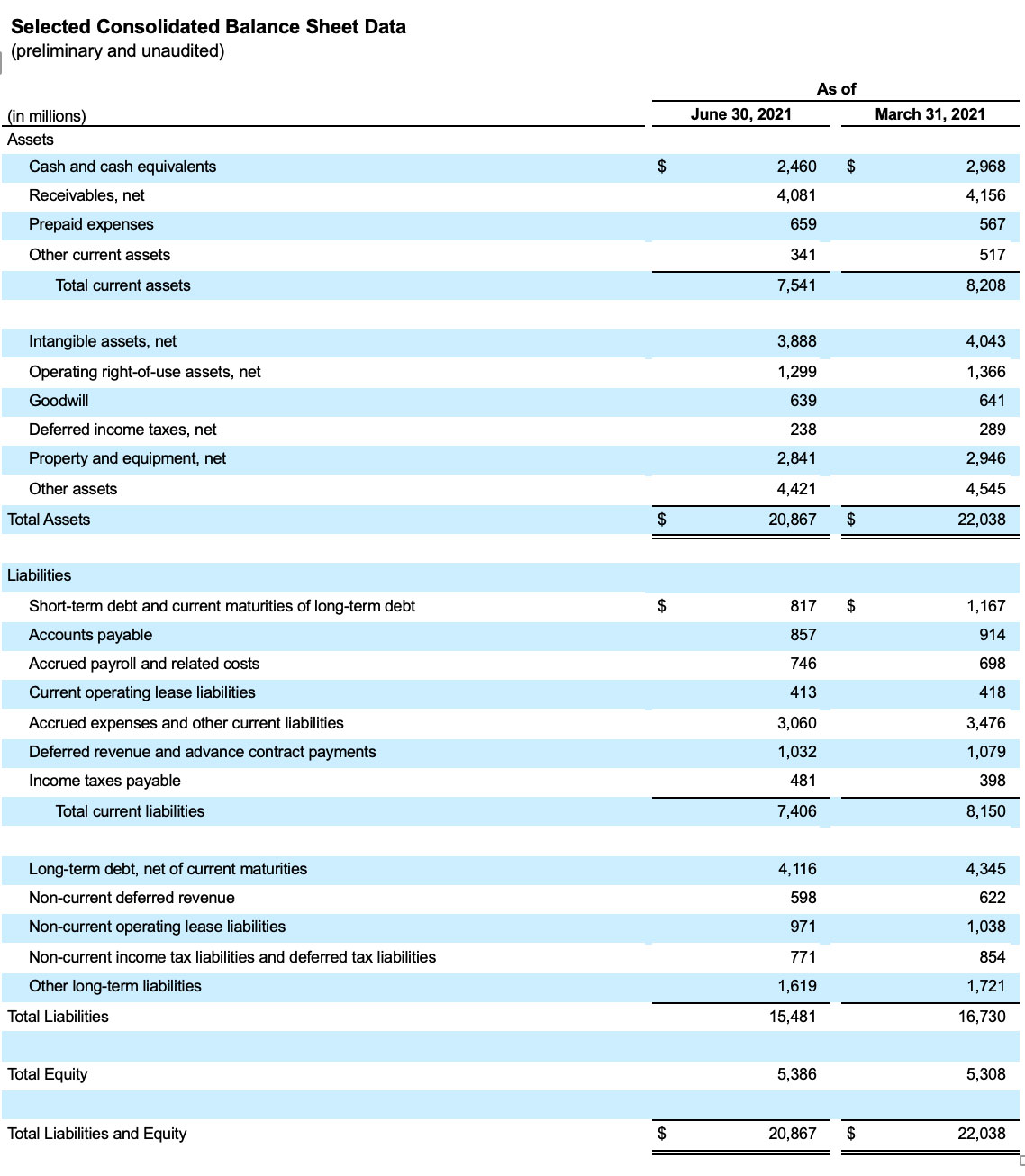
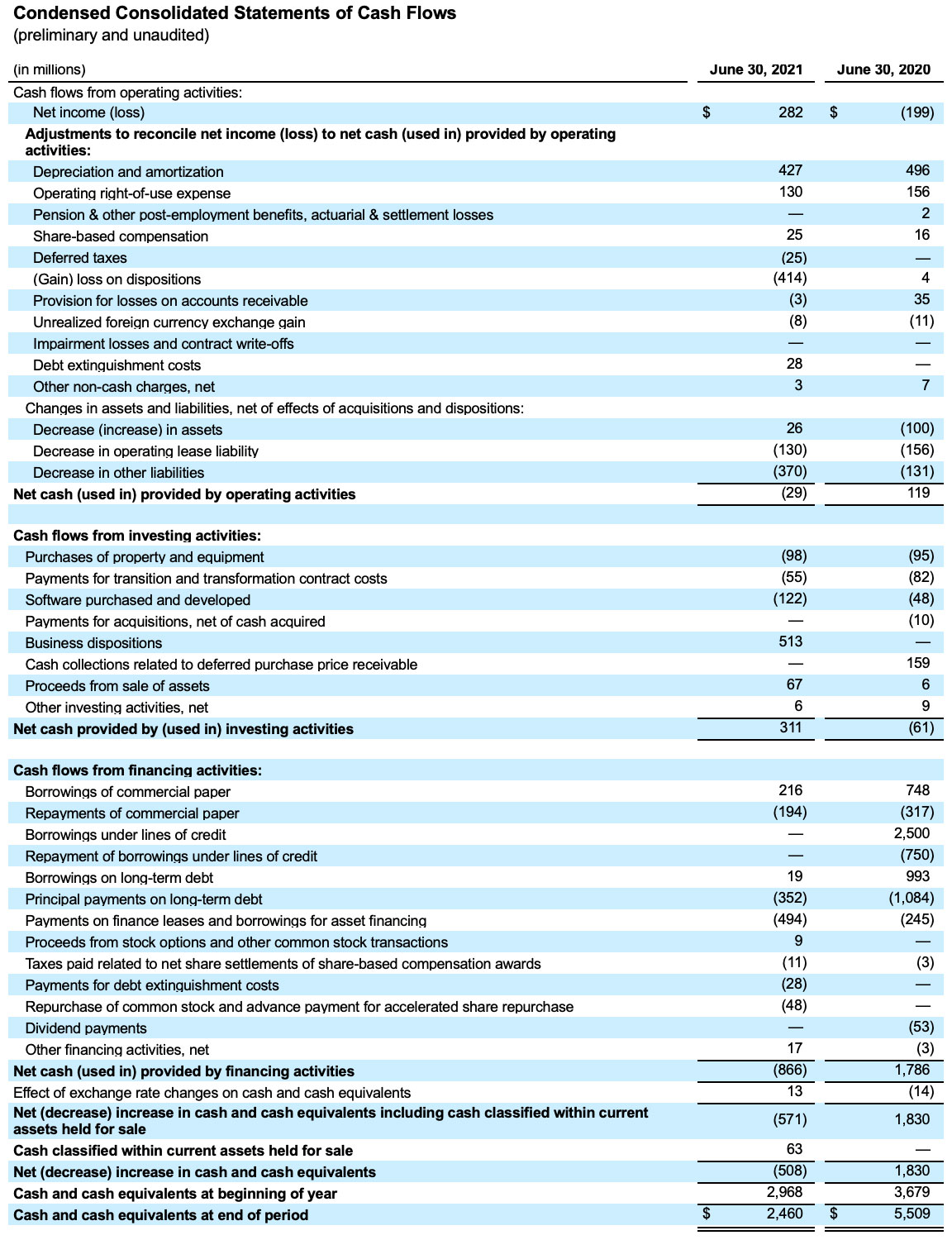
Segment Profit
We define segment profit as segment revenues less costs of services, segment selling, general and administrative, depreciation and amortization, and other income (excluding the movement in foreign currency exchange rates on our foreign currency denominated assets and liabilities and the related economic hedges). The Company does not allocate to its segments certain operating expenses managed at the corporate level. These unallocated costs include certain corporate function costs, stock-based compensation expense, pension and other post-retirement benefits (“OPEB”) actuarial and settlement gains and losses, restructuring costs, transaction, separation and integration-related costs, and amortization of acquired intangible assets.
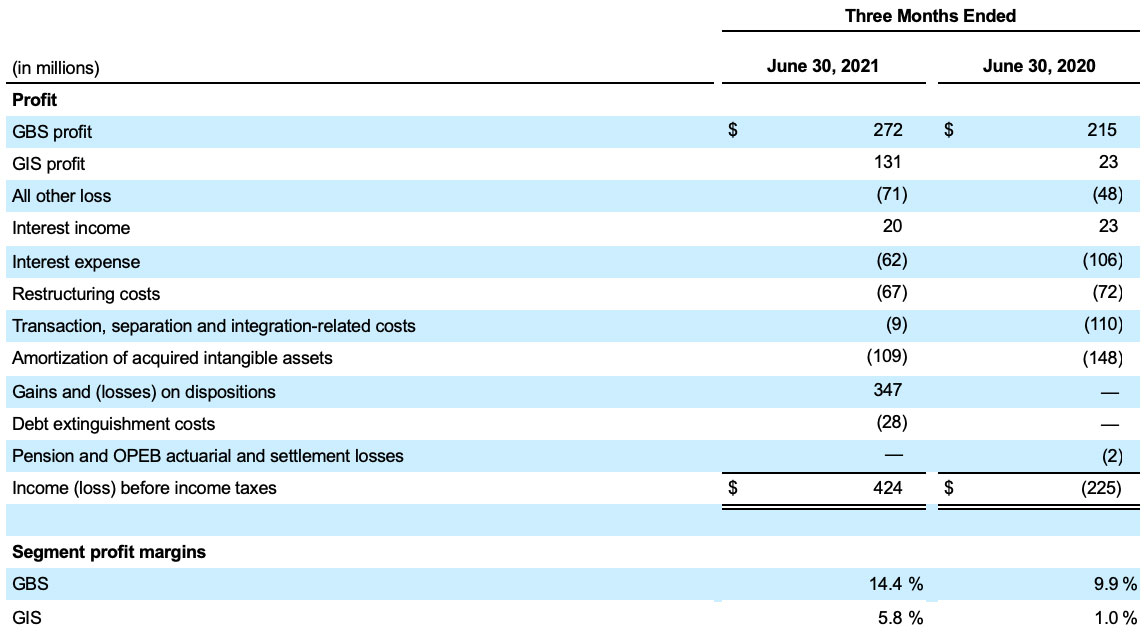
Reconciliation of Non-GAAP Financial Measures
Our non-GAAP adjustments include:
- Restructuring costs – includes costs, net of reversals, related to workforce and real estate optimization and other similar charges.
- Transaction, separation and integration-related (“TSI”) costs – includes costs related to integration, planning, financing and advisory fees and other similar charges associated with mergers, acquisitions, strategic investments, joint ventures, and dispositions and other similar transactions.(1)
- Amortization of acquired intangible assets – includes amortization of intangible assets acquired through business combinations.
- Gains and losses on dispositions – gains and losses related to dispositions of businesses, strategic assets and interests in less than wholly-owned entities.(2)
- Debt extinguishment costs – costs associated with early retirement, redemption, repayment or repurchase of debt and debt-like items including any breakage, make-whole premium, prepayment penalty or similar costs as well as solicitation and other legal and advisory expenses.(3)
- Pension and OPEB actuarial and settlement gains and losses – pension and OPEB actuarial mark to market adjustments and settlement gains and losses.
- Tax adjustments – adjustments to impair tax assets, merger and divestiture related tax matters, restructuring charges and income tax expense of non-GAAP adjustments. Income tax expense of other non-GAAP adjustments is computed by applying the jurisdictional tax rate to the pre-tax adjustments on a jurisdictional basis.(4)
(1) TSI-Related Costs include fees and other internal and external expenses associated with legal, accounting, consulting, due diligence, investment banking advisory, and other services, as well as financing fees, retention incentives, and resolution of transaction related claims in connection with, or resulting from, exploring or executing potential acquisitions, dispositions and strategic investments, whether or not announced or consummated.
The TSI-Related costs for the first quarter of fiscal 2022 include $11 million of costs to execute the strategic alternatives; $4 million legal costs and ($12 million) credit towards Perspecta Arbitration settlement, $4 million in expenses related to integration projects resulting from the CSC - HPE ES merger (including costs associated with continuing efforts to separate certain IT systems) and $2 million of costs incurred in connection with activities related to other acquisitions and divestitures.
(2) Gains and losses on dispositions for the first quarter of fiscal 2022 include a $341 million gain on sale of the HPS business, gains of $19 million on other dispositions and ($13 million) of adjustments relating to the sale of the HHS business.
(3) Debt extinguishment costs adjustments for fiscal 2022 include $18 million to fully redeem two series of our 4.45% senior notes due fiscal 2023, $3 million to partially redeem our 4.125% senior notes due fiscal 2026, and $7 million of debt associated with asset financing.
(4) Tax adjustment for fiscal 2022 reflects net revaluation of deferred taxes resulting from changes in non-US jurisdiction tax rates.
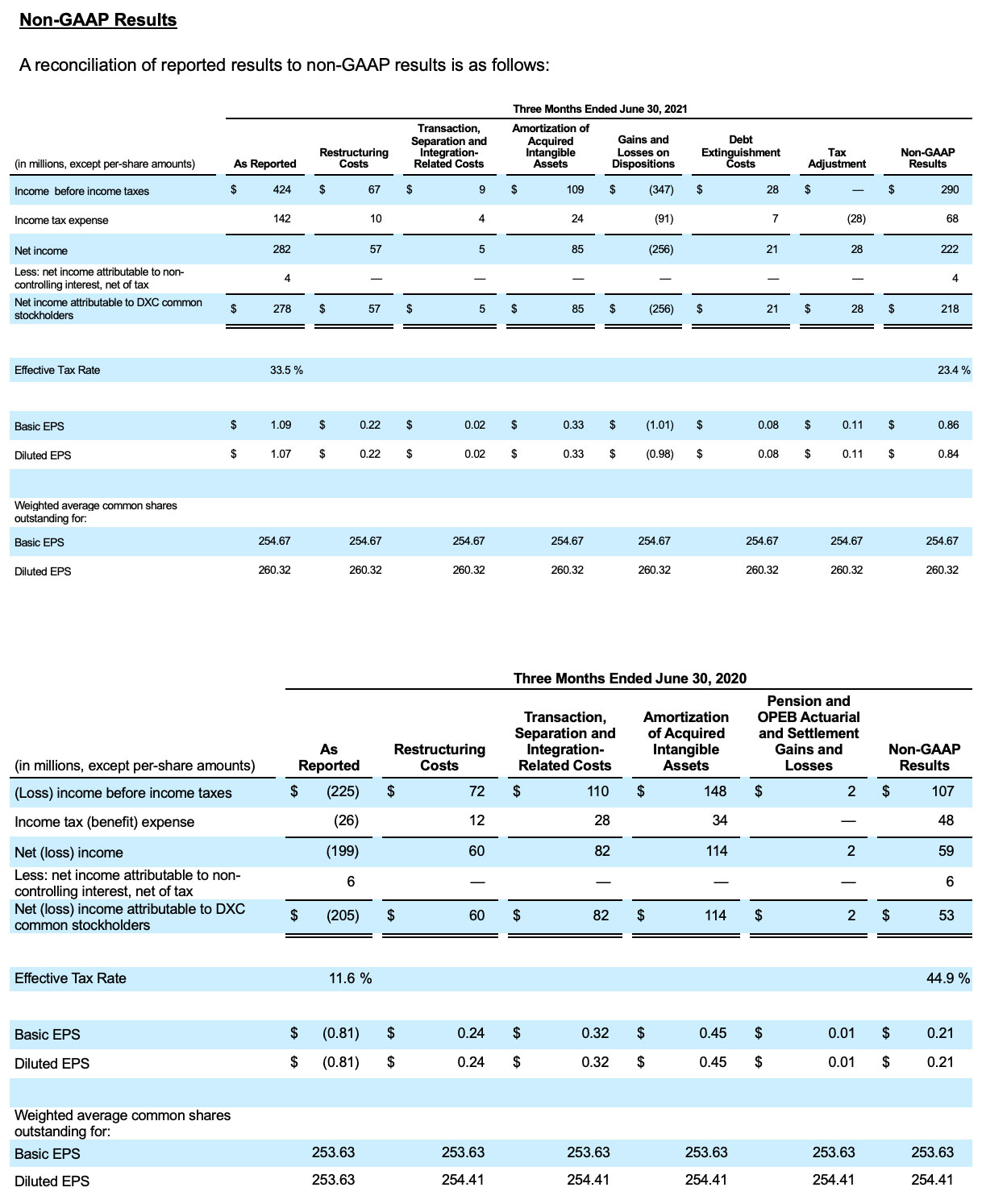
The above tables serve to reconcile the Non-GAAP financial measures to the most directly comparable GAAP measures. Please refer to the “About Non-GAAP Measures” section of the press release for further information on the use of these Non-GAAP measures.
